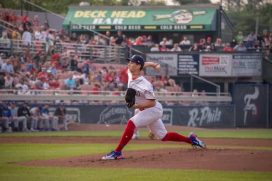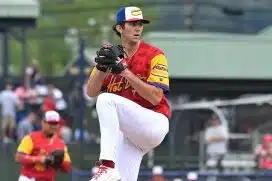By Tim Kelly, Sports Talk Philly editor
Former Philadelphia Phillies ace Curt Schilling may see an increase in his Hall of Fame votes in 2018, but it's unlikely to be enough for him to be in the Hall of Fame class of 2018.
Schilling, who is in his sixth year on the ballot, has received 65.4 percent of votes in public ballots thus far, according to Ryan Thibodaux's vote tracker. At the time of publication of this article, Thibodaux's tracker accounts for 45 percent of ballots that will determine the results of the Hall of Fame election. That means that Schilling would need to get just under 83 percent of the vote on the remaining ballots to be elected, per Thibodaux, a number that feels unlikely.
For what it's worth, 65.4 percent would be a more than 20 percent increase over the 45 percent of vote that Schilling garnered in 2017. It would top the 52.3 percent of the vote that Schilling received in 2016, which is the highest percentage of votes that he has gotten to date.
There's probably not a ton that can be done to sway voters who have been turned off by Schilling's outspoken political and social views, though he seems to be benefiting from it not being an election year. However, when you consider that Schilling was selected on just 29.2 percent of ballots in 2014, there does seem to be some realization that based off of Schilling's baseball career, he's worthy of induction to the Hall of Fame.
Nick Williams vs. Aaron Altherr: Who Is Projected To Have A Better 2018 Season?
Though Schilling's 216 wins don't jump off the page, some of his advanced numbers do. His 64.5 JAWS – a statistic that compares candidates to those already in the Hall of Fame at their position, is better than the average Hall of Fame starting pitcher. His JAWS is better than Hall of Famers Tom Glavine, Nolan Ryan, Jim Palmer and Juan Marichal, among others. Schilling's 79.9 bWAR tops the average Hall of Fame starting pitcher's bWAR of 73.9 by a comfortable margin. Here's a list of current/recently retired stars who have a lower bWAR than Schilling: Justin Verlander, CC Sabathia, Roy Halladay, Johan Santana, Andy Pettitte and John Smoltz. His 49.0 WAR 7 – which, in an oversimplified world, measures a player's seven peak years – is nearly equal to the 50.3 average of Hall of Fame starting pitchers.
Additionally, Schilling is one of the greatest postseason pitchers in the history of the sport. A lack of a ton of postseason appearances shouldn't be held against someone like Trevor Hoffman, who was a Hall of Fame caliber player. I would even argue that a lack of consistent postseason success shouldn't hurt someone like Clayton Kershaw, not that Kershaw will be a fringe candidate when he appears on the ballot. But for someone like Schilling, who pitched in the World Series for three different teams, his postseason success should serve as the cherry on top of his Hall of Fame candidacy. In 19 career postseason starts, Schilling went 11-2 with a 2.23 ERA and a 0.97 WHIP, while throwing four complete games, two of which were shutouts.
With more than half a decade to evaluate Schilling's case, voters seem to be realizing that Schilling pitched at a high enough level to warrant induction into the Hall of Fame. Even though it appears unlikely that Schilling will be part of the Hall of Fame class of 2018, he seems to be trending towards induction. Of course, Schilling has seen regressions in vote totals twice – he lost 9.6 percent between 2013 and 2014, and 7.3 percent between 2016 and 2017. So perhaps trying to predict the future of Schilling on the Hall of Fame ballot is an exercise in futility. That, of course, won't stop us from trying.







